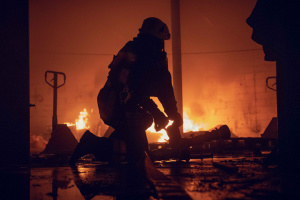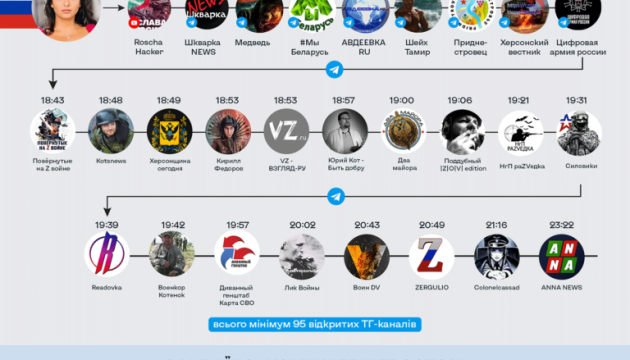
“Your Last Chance”: the Story of a Russian psyop
This is not the first example of a wartime psyop, there have been a lot of such materials since the beginning of the war. They are designed to weaken the military potential, which is a key goal of military propaganda.
This case was interesting because the professionally filmed video initially targeted the Armed Forces of Ukraine: Ukrainian servicemen were urged to surrender to the Russians; it was shot using perfect Ukrainian language and with the Ukrainian context.
But the Ukrainians skilfully turned the enemy’s weapons against it: they simply changed some visual elements in the video (the flag on the soldier’s chevron) and dubbed it in Russian. It is in this form — a call to the Russians for surrender — that the video became popular in Ukraine — fundamentally different from what the authors hoped for!
The failure of this operation unexpectedly led to the disclosure of its author. The head of the federal media holding Russia Today Margarita Simonyan publicly admitted that the author of the video Your Last Chance is… the Russian state television channel RT. Such a confession of Simonyan made it possible to expose one of the Russian networks for the distribution of propaganda materials to Ukraine. The Centre for Strategic Communication and Information Security has established which channels were used to conduct this information and psychological operation against the Ukrainian military. This is important in view of the fact that since they were involved in this psyop, they would be used in others.
Russian narratives in propaganda video
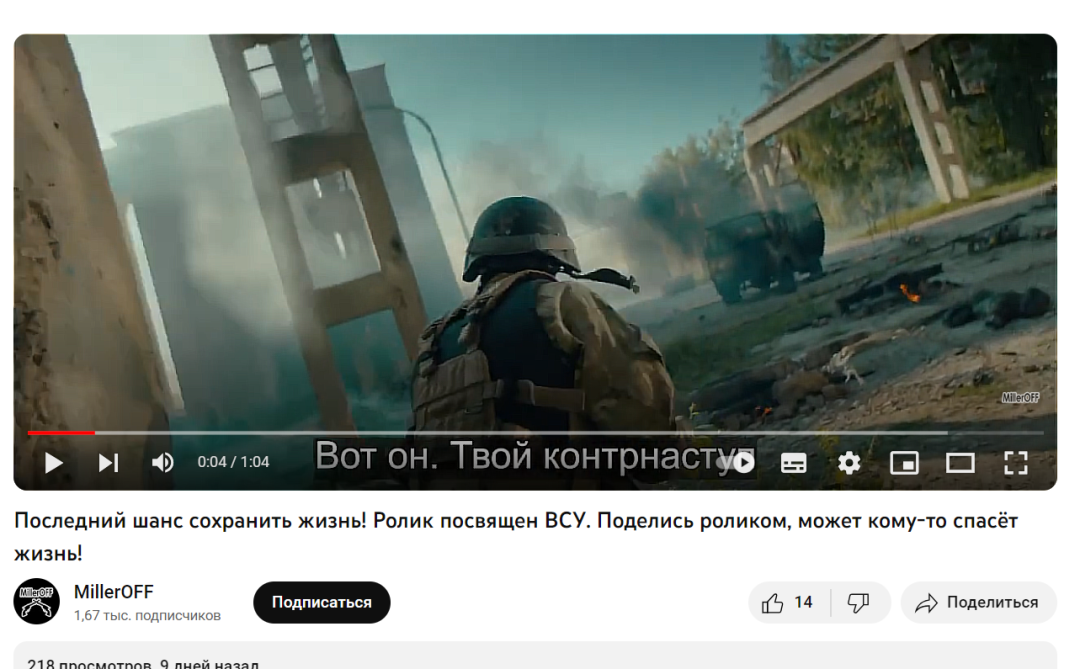
The video was shot considering the key messages of Russian propaganda about the “invincible Russia,” the resistance to which allegedly made no sense.
The main character of the video is a young guy who tried to avoid mobilization in various ways, but eventually ended up in the ranks of the Armed Forces of Ukraine.
The following messages were used to demoralize the Ukrainian audience:
“the Ukrainian counteroffensive failed”;
“Ukrainian men do not want to defend the Motherland”;
“total corruption in Ukraine”;
“mobilization is carried out by violent methods”;
“only ordinary men are mobilized”;
“the Ukrainian command values Western equipment more than the lives of soldiers”;
“the Russian army is invincible, to fight against it means to die”;
“the only chance to survive is to surrender.”
To enhance the effect, a meme about “fugitives in women’s dresses” was used, and “cannon fodder” was illustrated by a tin with stewed meat.
How the video was distributed in Russia
The oldest publication that was found on the Internet is a publication on the small YouTube channel Roscha Hacker. Published at 3:00 a.m. (Kyiv time) on August 28, the video had a total of 679 views in 13 days.
On the evening of August 28 (4:25 p.m. Kyiv time), the video appeared in an anonymous Telegram channel Shkvarka NEWS, specializing in the distribution of anti-Ukrainian content. The video has already 4,130 views on this channel.
Together with Telegram, the video began to appear on Z-groups and news channels on Russian social networks VKontakte (VK) and Odnoklassniki (OK). It was first published by the militarist channel Marines of Russia (4:34 p.m. Kyiv time) on Vkontakte, later — the channel News and Emergencies on Odnoklassniki (4:54 p.m. Kyiv time).
The starting point of the massive “spreading” of the video on Telegram can be considered its publication on the large Z-channels Sheikh Tamir and Digital Army of Russia (5:04 p.m. and 6:10 p.m. Kyiv time, respectively). The second channel is a platform for coordinating the actions of Telegram users involved in Russian psychological operations against Ukraine. Receiving content and tasks from channel administrators, users then distribute it on social networks, like posts or comments. The video had hundreds of thousands of views on these channels alone.
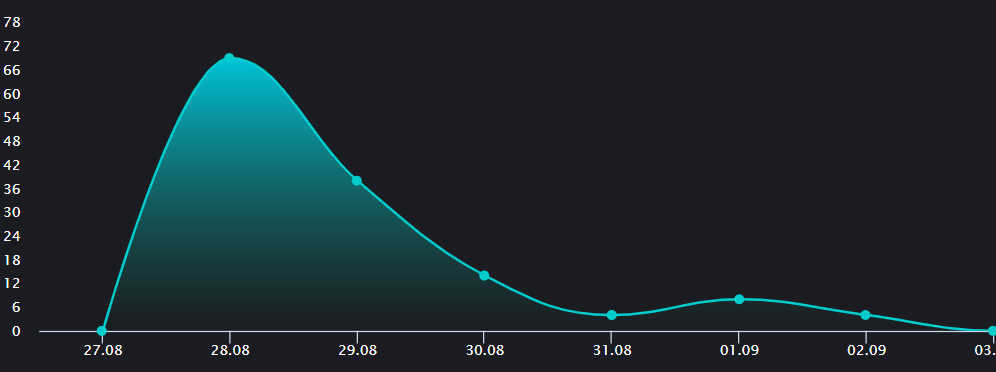
Dynamics of publications in Telegram and social networks
On August 28–September 1, the video was published by a number of Russian Telegram channels specializing in the war in Ukraine:
anonymous channels (Medved (Bear), Obsessed with Z War, Two Majors, Siloviki (Law enforcement officers));
personalized channels of war correspondents and Z-bloggers (KotsNews, Poddubny |Z | O | V| Edition, Voenkor Kotenok, ZERGULIO, Colonel Cassad, Yuri Kot — Kindness Will Prevail, Kirill Fedorov / War History Weapons);
channels of a number of Russian media (Readovka, Anna News, VZ – VZGLYAD-RU);
small pro-Lukashenka channels aimed at the Belarusian audience (#WeBelarus, Tsikhanouskaya’s Moustache, Belarusian Kitchen);
channels aimed at residents of Moldova, in particular, the occupied Transnistria (Pridnestrovets, TOT//MOLDOVA);
newly created Russian channels for Ukrainian regions (Kherson Region Today, Kherson Bulletin, AVDEEVKA RU).
The video was posted by at least 95 open Telegram channels. It is difficult to assess the involvement of closed channels similar to the Digital Army of Russia channel.
On Russian social networks VKontakte and Odnoklassniki, 69 and 29 publications of this video were identified, respectively. The following channels took part in its distribution:
Z-channels (Russia Forever, Russian Marines, Holy Rus, Reports of the Militia of Novorossiya, We Are Unif(V)ormed. MIA ROSGVARDIYA MILITARY (Vkontakte), NOD (Liberate the Fatherland from the Oppression of America) (Odnoklassniki));
pages of occupation administrations (Vladimir Saldo, Administration of Kherson Oblast);
news groups, including regional ones (Now | Frolovo, Komi Spotlight, Belgorod | We Are Together (Vkontakte))
pages of Russian media (Delovaya Gazeta VZGLYAD (Odnoklassniki), NewsFront | News, Vzglyad (Vkontakte));
entertaining channels (Incredible facts (Vkontakte), Interesting Communication (Odnoklassniki));
individual users (with miniscule audience and reach).
The video also appeared on a number of Russian websites: VZGLYAD, Komsomolskaya Pravda, Arguments and Facts, ZOV Kherson, ZOV COMBAT LEAFLET. The latter is associated with a group of supporters of Igor Girkin (Strelkov), who is currently in pre-trial detention after being charged with extremism.
On Twitter, the video was published on the page of the Russian online publication Vzglyad, which joined the distribution of the video on other sites: on Telegram, social networks VKontakte and Odnoklassniki.
On Youtube, the video is posted mainly on microchannels with a small audience. The only exception is the Sevastopol Life channel (161,000 subscribers), which managed to generate 10,000 views.
It is also worth noting the MillerOFF channel (1.67 thousand subscribers). It used to demonstrate game streams, but during the full-scale invasion, it switched to Z content, in particular, videos aimed at disrupting mobilization in Ukraine.
In addition to posting, the video was distributed by posting comments under other people’s posts on social networks and in Telegram chats. It was possible to identify 99 comments with this video that were left on VKontakte, 14 comments on Twitter, as well as 29 comments on YouTube. On the rest of the social networks, the number of identified comments is less than 10 in each.
Dynamics of posting comments on social networks
On YouTube, comments were posted mostly under the videos of Z channels.
A lengthy text praising the authors of the video was published by the Ukraina.ru website, which is part of the Simonyan-led Russia Today holding. The publication appeared on September 1, after the wave of video distribution on social networks began to decline and after the Ukrainians exposed the Russian psyop and tried to use it against the Russians.
How the video appeared in Ukraine
Since the addressee of the video Your Last Chance was a Ukrainian serviceman, the main task was to spread it in the Ukrainian segment of the media space. But after the blocking of Russian social networks and TV channels (including those mimicking Ukrainian ones, which were part of the pool of Medvedchuk’s TV channels), the capabilities of Russian propagandists in Ukraine have been significantly limited. Therefore, they actively work in the comments of promoted Ukrainian channels and popular videos on YouTube.
On this video hosting, the Centre found about 30 comments under the video (on the channels of Yurii Romanenko, Mykola Davydiuk, Channel 24, and others) with links to the video or calls to search for it typing Your Last Chance.
But the video was not distributed massively in this way. Effectively, it failed to reach the Ukrainian audience.
Instead, the Ukrainian side unexpectedly struck back: unknown authors made some technical changes to the video, radically changing its essence. Thus, the flag on the chevron of the soldier was replaced with a Russian one. The accompanying text was changed and read in Russian. Thus, the main character was already a Russian soldier, who was deceived by the Russian command and who was offered to surrender. After dubbing it in Russian and replacing the chevron of the main character, the video began to look much more organic.
On August 29, government agencies warned Ukrainians about the new Russian psyop. On August 31, the Telegram channels Pravda Grashchenko (at 9:24 a.m.) and the Project “I Want to Live” (at 10:56 a.m.) published the already amended and overdubbed video. It was in this form that the video became widespread in the Ukrainian information segment.
Conclusions
The video by Russian propagandists, created to demoralize the Ukrainian military, was distributed on social networks mainly to the Russian audience and therefore did not fulfill its task. Ukrainians were already informed about this psyop by Ukrainian government agencies, media, and organizations that studied and countered Russian propaganda.
Simonyan’s attempts and the resources under her control to further promote this video look like attempts to give the operation an additional impetus and report on the money spent.
In parallel with Simonyan, another Russian “office” launched a similar project. Although their product, unlike the RT video, turned out to be crappy from the beginning (illustration with the call “Save your life. Get in Touch” was designed with a grammatical error), but they went the other way to spread it: a mass mailing was carried out in the messengers Signal, Telegram, and Facebook targeting the accounts of Ukrainian activists, servicemen, journalists, diplomats.
This campaign has become more visible in the Ukrainian environment than the campaign by Simonyan, although equally ineffective, since it is impossible to change the situation with any gaming videos or pictures: real videos with demonstrative executions and tortures of Ukrainian prisoners of war, the murder of prisoners in Olenivka, and other violations of the laws and customs of war are a clear anti-advertising of captivity.
To continue, another video was spread: its main narrative is the question to the Ukrainian soldier “Why are you dying?” It states that one should not be doing it to rewrite history, for oligarchs, because of persecution of the Russian church, for “Poland, which seeks to seize a number of regions,” etc. As a result, we have a full set of Kremlin clichés, but in perfect Ukrainian. Although for the European part, Russian propagandists made a video dubbed in English.
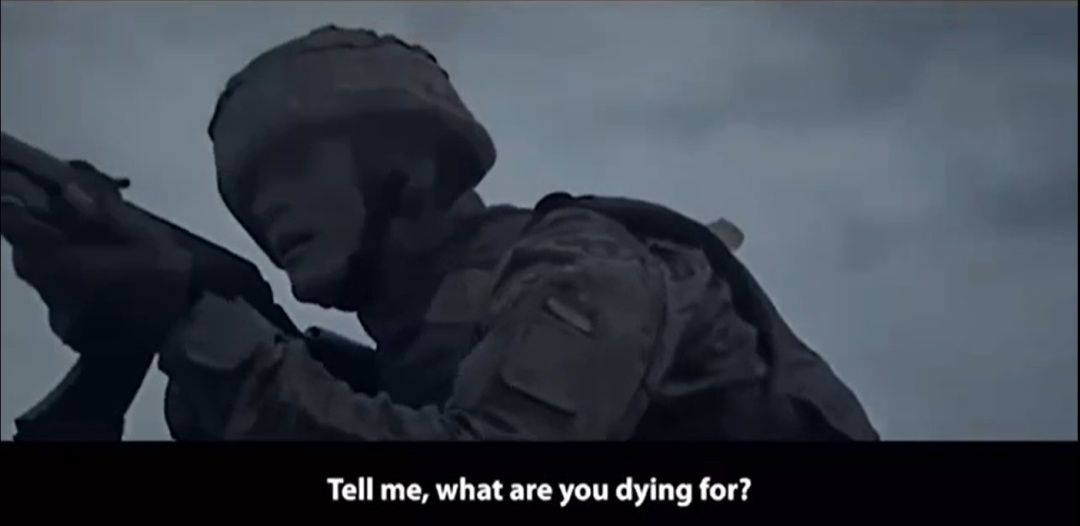
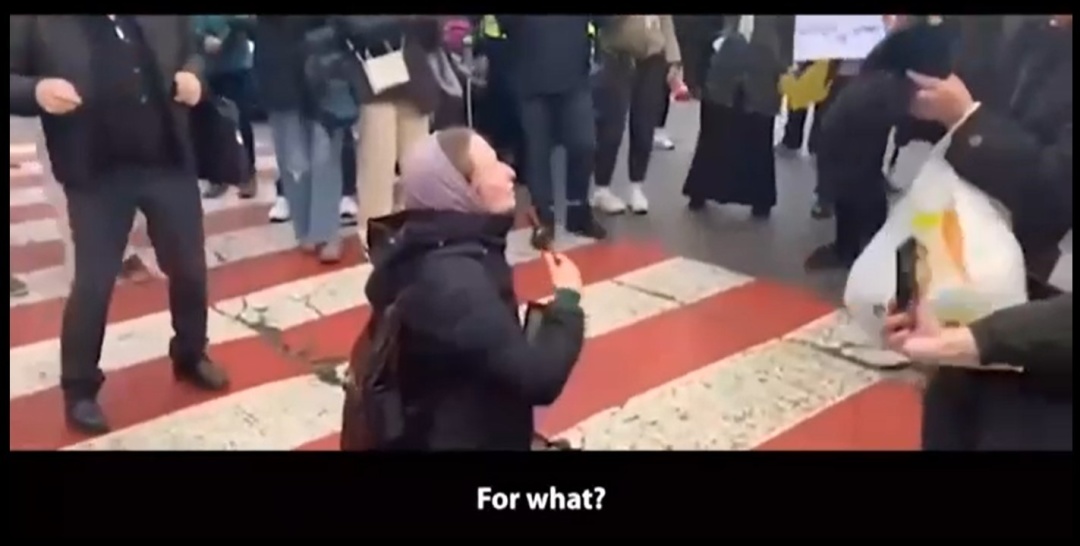
Although the authors of all these campaigns failed to promote the video to the Ukrainian audience, such activity may indicate the activation of various Russian structures working against Ukraine and even competition between them. This means that there will be more and more attempts to influence the consciousness of the Ukrainian military through other psyops.
Center for Strategic Communication and Information Security



